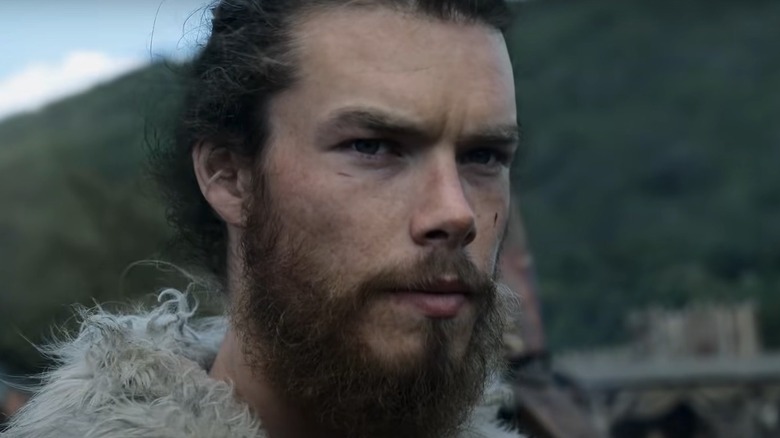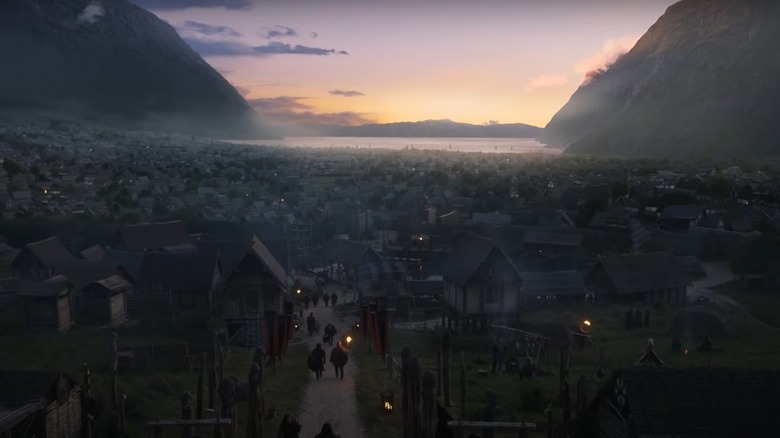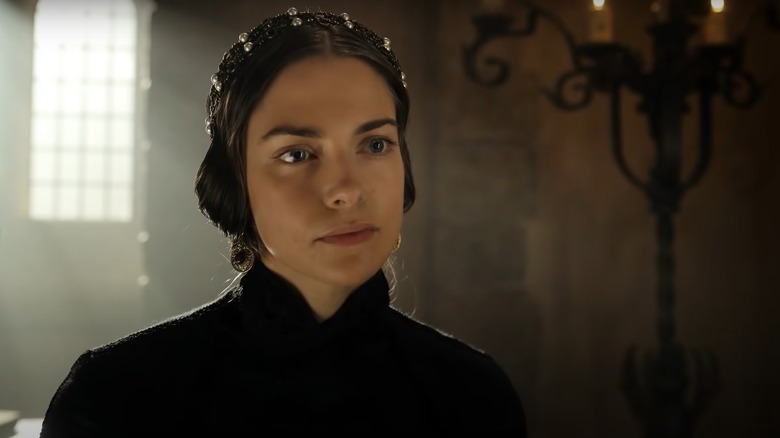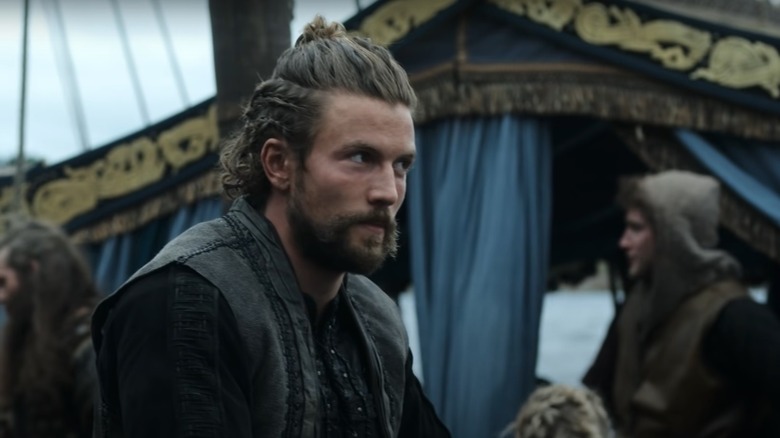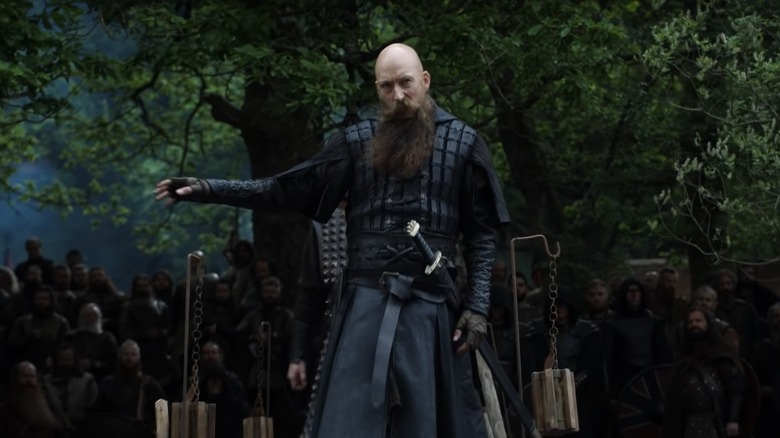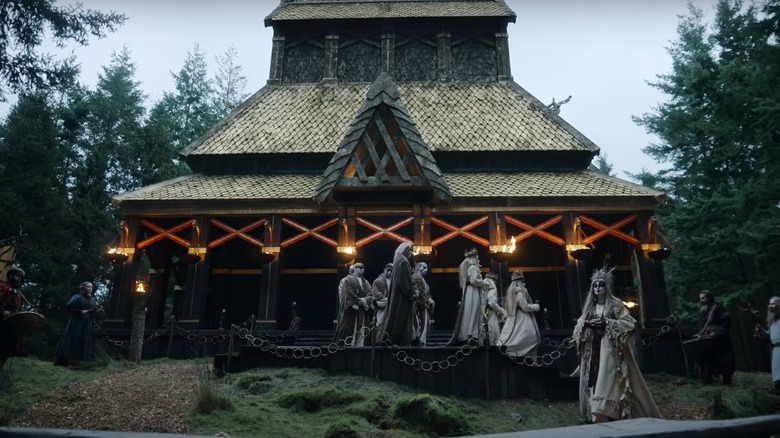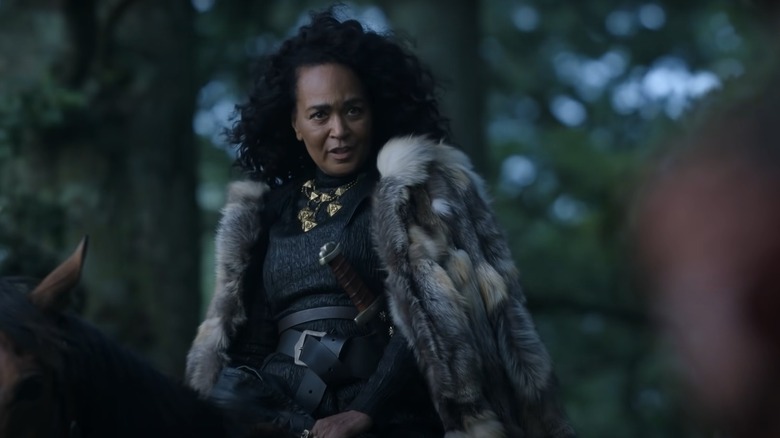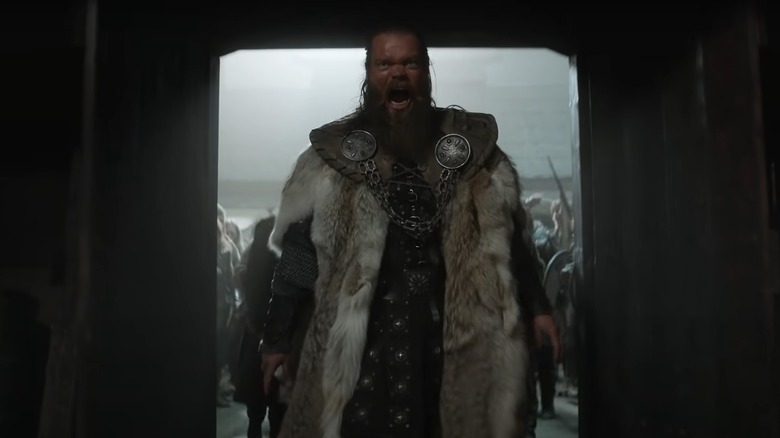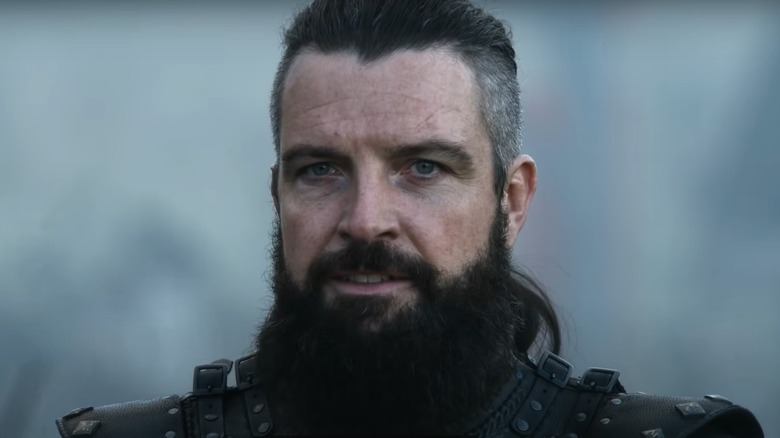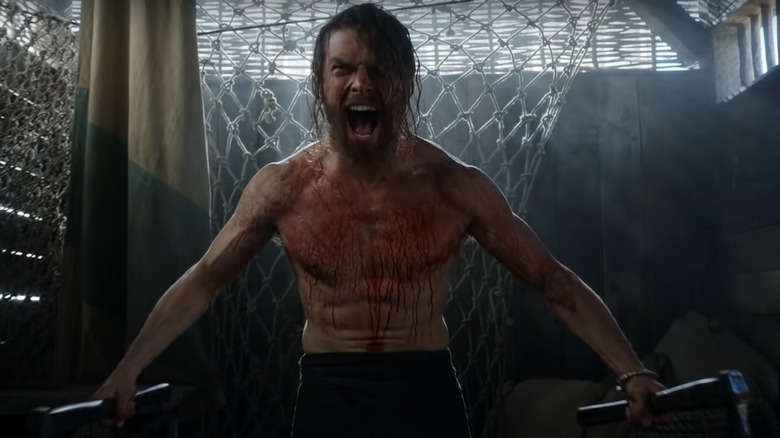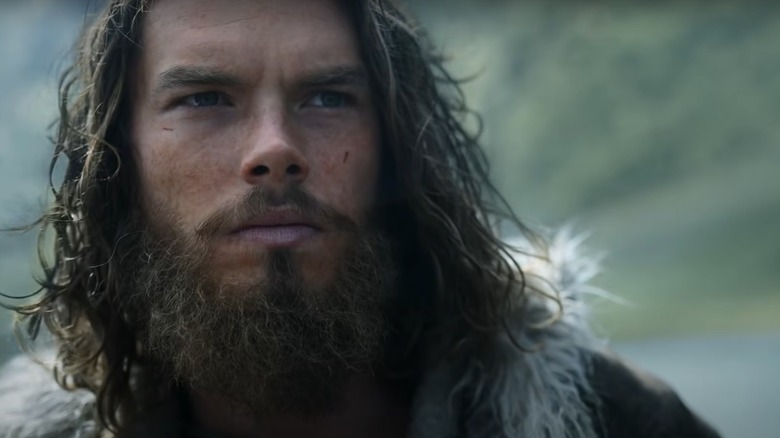Small Details You Missed In Vikings: Valhalla
As the first-ever scripted series from History, a lot was riding on the success of Michael Hirst's "Vikings." The show was loosely based on "The Saga of Ragnar Lothbrok and His Sons," a text created by the people of Iceland to preserve Viking history amid the spread of Christianity in Northern Europe (via Sons of Vikings). It spanned the beginning of the Viking age, from the famous sacking of Lindisfarne in England to the arrival of the Great Heathen Army, intent on avenging Ragnar's death at the hands of King Ælla of Northumbria. Hirst's show was a huge hit for History, earning a dedicated fanbase and widespread critical acclaim over six bloody seasons. But Ragnar's story isn't the only Viking saga to have survived.
In 2022, fans returned to the world created by Hirst via Netflix's sequel series "Vikings: Valhalla," set 100 years after the events of the first show. Creator Jeb Stuart pulls from "The Saga of Erik the Red" and "The Saga of the Greenlanders," in which Leif Erikson features heavily. Played by Australian actor Sam Corlett ("Chilling Adventures of Sabrina"), Leif takes over from Ragnar as our new protagonist, and the two have much in common. He's joined by his sister, Freydís Eiríksdóttir (Frida Gustavsson), Harald Sigurdsson (Leo Suter), and a host of other well-known names from the dying days of the Viking age.
There's a whole lot going on in "Vikings: Valhalla," so here are all the small details you may have missed. Major spoilers for "Vikings" and "Vikings:Valhalla" ahead.
Kattegat learned some lessons from the Paris raids
Kattegat was just a small port town when we first saw it in "Vikings," but the former seat of Ragnar Lothbrok has grown into a bustling, multicultural center of trade by the time "Vikings: Valhalla" begins, spreading from the shore of the fjord right up into the valley beyond. It's a free city and the center of the Viking world in Norway, and as such, it needs to be protected. The location comes with natural defenses — notably, the narrow entryway makes it difficult for a fleet of invading ships to enter en masse. It's better to be safe than sorry, however, which is why there's a new addition to the port that was apparently inspired by Ragnar's greatest defeat.
Ragnar's raid of Paris was one of the standout moments on "Vikings" — he fakes his death and enters the city in a coffin, having undergone a sham conversion prior to his staged passing. But when he returns to the Frankish capital a second time, he is outsmarted by a thick chain the Franks had installed across the river Seine, hidden below the surface. When the Viking fleet gets close, the Franks pull the chain up and cause a mass pile-up, sinking many ships and repelling the invading force. Perhaps inspired by that very moment, Kattegat now uses a similar device in its harbor, making doubly sure that unwelcome ships cannot dock. As if that wasn't enough, they've now got their own trebuchets, too.
Emma of Normandy takes after her famous Viking relative
The chain device that foiled (at least for a while) Ragnar and company when they returned to Frankia was the brainchild of Rollo, the first Duke of Normandy and Ragnar's brother. Overlooked and underappreciated, Rollo decides to switch sides when the Franks come to him with an offer: defend Paris from further Viking attacks, and he would be made a rich man. He is given land (which would become known as Normandy, as in the land of the Northmen) and offered the hand of Princess Gisla, daughter of Emperor Charles II. It's an uneasy union to begin with, but Gisla comes to trust and even love her Viking husband after he saves her beloved city from his own kind.
In "Vikings: Valhalla," King Æthelred of England is married to a Norman woman, Queen Emma. When he dies, the defense of England is left to Emma, and she's forced to channel her inner Viking. As a member of her court remarks in a throwaway line that you might have missed, who better to defend England from the Vikings than the great-granddaughter of Rollo himself? There are many parallels between the two: As Emma points out, she was a stranger to England when she arrived but was able to master the language and gain the trust of the people. Rollo would no doubt be proud of his great-grandaughter, who proves herself to be a real survivor over the course of the 1st season.
King Harald's great-grandson is on the same quest
Prince Harald Sigurdsson reveals early on in "Vikings: Valhalla" that he is the great-grandson of a man known as Harald Finehair. That name will probably mean nothing to you if you've joined the party with "Vikings: Valhalla," but those who watched "Vikings" will know that Harald Finehair was a Viking king who defied the odds to become king of all Norway. He believed that it was his destiny to rule over his homeland, and it put him at odds with Ragnar and his sons at times. In Prince Harald's case, his ambitions pit him against his half-brother, King Olaf. Olaf Haraldsson (Jóhannes Jóhannesson) has promised Prince Harald that the throne of Norway will go to him upon his death, but what he doesn't tell him is that he's had a son in secret.
According to King Canute of Denmark (Bradley Freegard), Olaf plans to have his son take over after he's gone, cutting Harald out of the picture. If Harald joins forces with Canute on his quest to create a great Northern empire, he will guarantee him the Norwegian crown. Will Harald eventually achieve his dream, just like his great-grandfather did? That will no doubt be addressed in coming seasons of "Vikings: Valhalla," but those of you who are up on your Viking history will know that Harald Sigurdsson became known as Harald Hardrada, meaning Harald "hard ruler." There are big things to come for Leo Suter's character.
What is the symbol on Jarl Kåre's hand?
Both Harald Sigurdsson and Olaf Haraldsson are Christian Vikings, though the latter is far more stern in his beliefs, with little patience for the old Pagan ways. However, he pales in comparison to Jarl Kåre (Asbjorn Krogh Nissen), a zealot who wants to wipe away the Old Gods completely. He's absolutely ruthless when it comes to spreading the word of Jesus Christ, brutally murdering any Pagans he comes across. When we see his backstory, the reasons for his warped worldview become crystal clear — Kåre was brought up Pagan, and as a child, he witnessed his brother die as a human sacrifice to the gods.
Kåre wears gloves most of the time, and when he returns to Uppsala (the holiest Pagan site in Scandinavia), we realize that he's been covering up his past — quite literally. He gains entry to the temple by showing the guard a Y-shaped symbol tattooed on the palm of his hand. This symbol is known as Algiz, the ancient Norse rune of protection. According to Symbol Sage, "It's believed that the ideographic representation of the symbol is derived from a splayed hand, a swan in flight, the horns of an elk, or even the branches of a tree." It's been seen many times in the Vikings universe — it was on one of the rune stones that Ubbe and Torvi left for the native North Americans as gifts upon arriving in the so-called Golden Land.
Jarl Kåre takes a leaf out of Ragnar's book
When Jarl Kåre returns to Uppsala posing as a Pagan, he heads straight to the altar where his brother had his throat cut to appease the gods and proceeds to carve his Algiz tattoo out of his palm. It's a brutal scene, but it's nothing compared to what he has planned for the priests of the holy Pagan site. After talking to the Seer once more (the supernatural Pagan oracle presented himself to Kåre after his brother's death, but the latter still turned to Christianity), the jarl and his berserkers go on a rampage, slaughtering everyone at Uppsala and burning the prized temple to the ground. Kåre and his men leave a few kids alive, but not out of mercy — they want them to tell the Pagans of Kattegat that they're next.
That's not quite enough to prove his point, so Kåre takes a page out of Ragnar's playbook to really scare his enemies. He beheads the priests and attaches their severed heads to a boat, which he sends floating towards Kattegat. Ragnar uses this very tactic while trying to terrify the Mercians over in England, and it works very well (one of the heads hanging from his mast is actually a fake Travis Fimmel head, eagle-eyed "Vikings" fans will have noticed). Still, Kåre knows the people of Kattegat are a tough breed, so for good measure, he crucifies the head priest, nailing her to the mast of the ship.
The attack on Kattegat was foreshadowed long ago
When we return to Kattegat in "Vikings: Valhalla," it's being ruled by Jarl Haakon (Caroline Henderson), a Pagan Viking of African descent (the Norse exploration of Africa began with Björn Ironside in "Vikings" Season 5). She reveals to Freydís Eiríksdóttir that she's had dreams in which the water next to Kattegat recedes into the ocean, revealing a bounty of fish. The people believe it to be a blessing from the gods, but when the water returns, it causes widespread death and destruction. Of course, it's the tsunami that Haakon has dreamed of, and one that was foreshadowed long ago in Season 4 of "Vikings."
The opening credits sequence of "Vikings" always stuck with the song "If I Had a Heart" by the Swedish singer-songwriter Fever Ray, though the imagery was tweaked and updated from season to season. In Season 4's opening credits, a brief shot shows a tsunami wiping out Kattegat, but it doesn't come from the sea — it comes from the direction of the valley. How can a tsunami come from inland? As "Vikings: Valhalla" Season 1 nears its end, Kåre and Olaf launch their assault on Kattegat. They trick Haakon and her allies into thinking they will use the high tide provided by the wolf moon to attack from the sea, when in fact, they plan to come from the other side, throwing a wave of Christian warriors at the city.
The walls of Kattegat have not been breached in 100 years
Planning his attack, Olaf remarks, "The walls of Kattegat have not been breached in 100 years." It's a throwaway comment about a bygone era to many of his men, but those who watched "Vikings" will know exactly what he's talking about. The Kattegat Civil War was one of the major events in the first series, fought between the sons of Ragnar. Lagertha (Katheryn Winnick) decides to pounce when they are away from Kattegat, overthrowing Alyssa Sutherland's Queen Aslaug. Being Lagertha's son, Bjorn takes her side, while Aslaug's sons want revenge. Forces led by Ivar the Boneless assault Kattegat but are defeated. After calling in a favor from his uncle Rollo — now a powerful man in Frankia — Ivar's forces return, and with the help of a thousand Frankish soldiers, the invading army forces Lagertha to flee.
Ivar takes power, but he seals his own downfall by proclaiming himself a god and turning those closest to him against him. The walls of Kattegat are only fully breached by Bjorn and company because Ivar's wife Freydís secretly opens a gate and lets them in. A century later, Olaf manages to do it by force — but he has to flee within minutes of his great victory. Having secured his son's fleet, Canute's father, Sweyn Forkbeard, arrives to deal with the men he deems traitors. What is left of Olaf's army flees at the sight of his banners, and he's not far behind them.
King Canute gets his loot
When King Canute of Denmark decides to stay in England and rule the country, it surprises Vikings and Saxons alike. He needs the wealth of England to make his great Northern empire a reality, which is why he decides to keep Edmund — the recently crowned replacement of the late King Æthelred — as a puppet to control the problematic English nobles. But before he gets to politics, he needs to know that all 11 nobles are serious about their commitment to him, so he has 11 gallows erected. He then sends Earl Godwin (David Oakes) to fetch the nobles, who, having been stripped of their possessions and locked in a cell, have no idea of what awaits them.
The defiant noble from Northumberland can be seen fiddling with his fancy rings as he insults Godwin for "kissing the arse of the enemy," which is a big mistake: Godwin invites him to go up and see the new king first. When the other nobles follow, one of the gallows is used to kill their counterpart from Northumberland. Canute proceeds to give the remaining nobles a choice, and as he addresses them, he can be seen turning something shiny around in his fingers. It's only visible for a moment as he tosses it to his right-hand man, but it's clearly one of the rings that the noble from Northumberland wore so proudly. He may be the new king of England, but he's still a Viking at heart.
The awakening of Leif the Red
Leif Erikson is one of the most famous Vikings of all time, credited with establishing a settlement in North America some 500 years before Christopher Columbus arrived in the New World (via History). At the beginning of "Vikings: Valhalla," however, Leif still lives in the considerable shadow of his father. Erik the Red is a notorious murderer who was banished from Norway and then from Iceland for his crimes, forcing him to make a home on Greenland (he gave the icy island its deceptive name, hoping to attract more would-be settlers). When Leif arrives at Kattegat with his sister, Freydís Eiríksdóttir, and a crew of Greenlanders, he's recognized as the son of a dishonorable man. He's even attacked for it, but he proves that he's not a killer by sparing the men who tried to take his life.
Leif later reveals that the same "darkness" that drove his father lives in him, too, and that he only feels calm and content when he's with fellow Greenlander, Liv (Lujza Richter). The pair form a romantic relationship as part of King Canute's army, becoming closer still after their comrades from the north fall in battle. When Liv is killed by King Olaf during his successful assault on Kattegat, the darkness that Leif spoke of comes to the surface. The Greenlander becomes his infamous father, and he kills so many men in his rage that he's literally red, his chest and torso covered in blood.
Will Leif become a Christian?
When the Viking army arrives in England to avenge the slaughter of their people in the St. Brice's Day massacre, they have to figure out how best to attack London. They decide to follow the advice of King Olaf (who spent time at the court of King Æthelred and therefore has knowledge of the city's defenses) and attempt to approach London through the marshlands, thought impassable by many. Their approach is anticipated, however, and the scouting party (made up primarily of Leif and the Greenlanders) is ambushed. Some of Leif's friends are killed, and he's presumed dead. As he appears to be slipping away, he opens his eyes to see a little local girl looking down at him. She places a cross in his hand.
Leif survives, and he can't help but wonder if the cross had something to do with it. When Liv takes an arrow in the shoulder, and her chances of pulling through seem slim, he secretly leaves the cross with her — and she also survives. There are several little moments that hint at Leif moving away from Pagan beliefs and embracing Christianity, some more subtle than others. When Jarl Haakon sanctions a human sacrifice as they prepare to defend Kattegat, others watch on in awe as the volunteer is killed, while the look on Leif's face suggests that he's uncomfortable at best. Ragnar flirted with Christianity during his lifetime, and it appears as though Leif will do the same.
